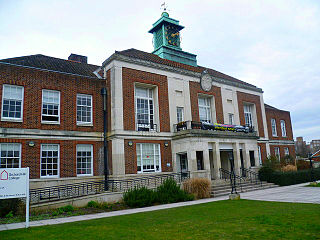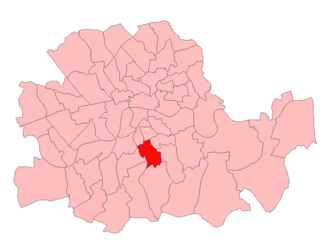Related Research Articles

Beddington is a suburban settlement in the London Borough of Sutton on the boundary with the London Borough of Croydon. Beddington is formed from a village of the same name which until early the 20th century still included land which became termed entirely as Wallington. By the 13th century, the latter was also partially known as Hakebrug, and named after a bridge on the River Wandle. The locality has a landscaped wooded park at Beddington Park – also known as Carew Manor; and a nature reserve and sewage treatment works in the centre and to the north of its area respectively. The population of Beddington according to the 2011 census is 21,044.

Wimbledon is a constituency in Greater London represented in the House of Commons of the UK Parliament. Since 2024, the seat has been held by Paul Kohler of the Liberal Democrats.

The region of Greater London, including the City of London, is divided into 75 parliamentary constituencies which are sub-classified as borough constituencies, affecting the type of electoral officer and level of expenses permitted. Since the general election of July 2024, 59 are represented by Labour MPs, 9 by Conservative MPs, 6 by Liberal Democrat MPs, and 1 by an independent MP.

Beddington and Wallington was, from 1915 to 1965, a local government district in north east Surrey, England. It formed part of the London suburbs, lying within the Metropolitan Police District and the London Passenger Transport Area. In 1965 it was abolished on the creation of Greater London.
Wednesbury was a borough constituency in England's Black Country which returned one Member of Parliament (MP) to the House of Commons of the Parliament of the United Kingdom from 1868 until it was abolished for the February 1974 general election.

Mitcham was a constituency comprising the emerging Mitcham, Wallington and Beddington suburbs of South London and until 1945 that of Carshalton, its largest of the area's four traditional divisions, in its south-west. It returned one Member of Parliament (MP) to the House of Commons of the Parliament of the United Kingdom by the first past the post system.
Carshalton was a constituency combining with areas to the south-west, then to the east instead, Carshalton which is a suburb on a long, north–south hillside south of London. The latter form saw it take up an eastern "half" of the London Borough of Sutton. It returned one Member of Parliament (MP) to the House of Commons of the Parliament of the United Kingdom.

Camberwell North was a borough constituency located in the Metropolitan Borough of Camberwell, in South London. It returned one Member of Parliament (MP) to the House of Commons of the Parliament of the United Kingdom. The constituency was created for the 1885 general election, and abolished for the 1950 general election.
Parliamentary by-elections in the United Kingdom occur when a Member of Parliament (MP) vacates a House of Commons seat during the course of a parliament.
Henry Newton Knights MBE was a British businessman and Conservative Party politician.

An election to the County Council of London took place on 2 March 1922. It was the eleventh triennial election of the whole council. There were sixty dual member constituencies and one four member constituency, making a total of 124 seats. The council was elected by First Past the Post with each elector having two votes in the dual member seats.
The 1920 Northampton by-election was a parliamentary by-election held for the British House of Commons constituency of Northampton on 1 April 1920.

The 1944 Camberwell North by-election was a by-election held on 31 March 1944 for the British House of Commons constituency of Camberwell North.
Major Sir Patrick Bernard Malone was a British Conservative politician.
Frederick William Cundiff was a British soldier, politician and businessman.

Tom Myers was a British Labour Party politician.
Arthur Leonard Bateman was a British businessman and Conservative Party politician.

The 1920 Camberwell North West by-election was a parliamentary by-election held for the British House of Commons constituency of Camberwell North West in the South London district of Camberwell on 31 March 1920.
The 1964 Sutton Council election took place on 7 May 1964 to elect members of Sutton London Borough Council in London, England. The whole council was up for election and the Conservative Party gained control of the council.

Wallington Town Hall is a municipal building in Woodcote Road, Wallington, London. It is a Grade II listed building.
References
Leigh Rayment's Historical List of MPs
- 1 2 3 4 5 "Obituary: Sir Richard Meller M.P.". The Times . 24 June 1940. p. 9.
- ↑ "The By-Elections". The Times . 11 March 1920. p. 14.
- ↑ "By-Election Results. Labour Triumph At Dartford". The Times . 12 April 1920. p. 15.
- ↑ "North Camberwell By-Election. No Coalition Candidate". The Times . 10 February 1922. p. 15.
- ↑ "Another Labour Gain. Big Majority In Camberwell". The Times . 21 February 1922. p. 10.
- ↑ "Beddington And Wallington. New Borough's Charter Presented". The Times . 16 September 1937. p. 14.